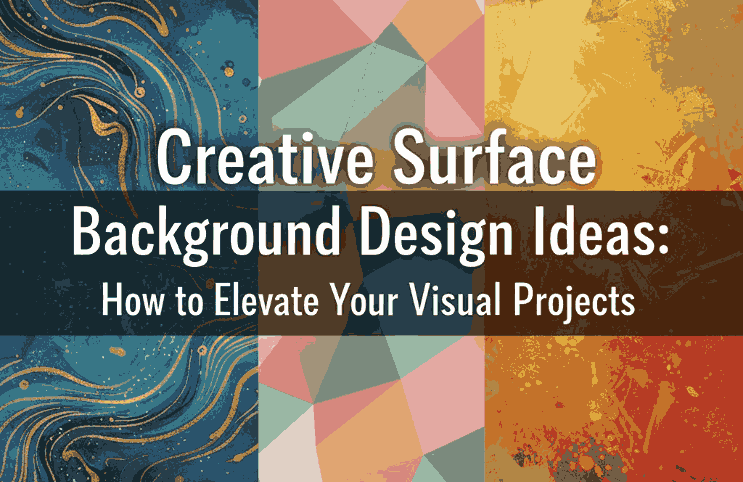
Table of Contents
- Introduction: The Role of Backgrounds in Design
- Understanding Surface Background Design
- Types of Surface Backgrounds in Modern Design
- How to Choose the Right Surface for Your Project
- Enhancing Surface Backgrounds with Typography
- Font Examples to Pair with Surface Backgrounds
- Final Thoughts
- References
1. Introduction: The Role of Surface Background Design Ideas
In graphic design, the Surface Background Design Ideas is more than just a backdrop — it’s the foundation that sets the mood, tone, and atmosphere of your visual story. A well-chosen background complements the subject, enhances typography, and creates emotional depth.
Among the many approaches to backgrounds, surface background design stands out for its versatility and tactile appeal. Whether you’re designing posters, packaging, digital ads, or social media content, using surface backgrounds can help you create textures that feel real, inviting, and professional.

2. Understanding Surface Background Design Ideas
Surface background design refers to using textures, patterns, and material-inspired visuals (like wood, marble, paper, or fabric) as the main visual foundation of a design. It brings a sense of realism, helping your audience emotionally connect with your artwork.
Common types of surface backgrounds include:
- Textured surfaces – concrete, paper grain, sand, or fabric.
- Natural surfaces – wood, leaves, water ripples, or marble.
- Industrial surfaces – metal plates, brushed steel, or stone.
- Minimal surfaces – flat tones, gradients, or subtle shadows.
These backgrounds can be real photographs, digital textures, or vector-based patterns, depending on your project’s style.
3. Types of Modern Surface Background Design Ideas
Surface backgrounds can be classified based on the emotional tone or design goal. Let’s explore a few examples used by professional designers:
a. Organic Surfaces
Organic backgrounds use natural elements like wood, stone, or plants. These are ideal for eco-friendly brands, wellness products, or nature-inspired campaigns.
b. Minimal and Flat Surfaces
These use smooth gradients or single-tone colors, perfect for modern branding or tech industries. Minimal surfaces help the main elements (like logos or text) stand out.
c. Textured & Rough Surfaces
Textures like rough paper, brick, or fabric bring depth and authenticity. Great for handcrafted product branding, coffee shops, or vintage aesthetics.
d. Abstract & Artistic Surfaces
These designs use brush strokes, gradients, or abstract shapes. Ideal for creative studios and art-based promotions, they evoke emotion and movement.
4. How to Choose the Right Surface Background Design Ideas for Your Project
When selecting a surface background, always consider the purpose and audience of your design. Here are a few practical tips:
- Match your brand tone: Use sleek surfaces for corporate brands and rough textures for artisanal ones.
- Prioritize readability: Avoid overly busy textures behind important text.
- Use contrast wisely: Pair dark text with light backgrounds (and vice versa).
- Stay consistent: Maintain a unified visual theme across all brand materials.
- Experiment with blending: Use overlays and opacity adjustments to harmonize the surface with your typography or logo.
Remember — your background should support your message, not compete with it.

5. Enhancing Surface Background Design Ideas with Typography
Typography and background are inseparable. A surface background provides the visual context, while typography delivers the message. The right combination turns your design from ordinary to unforgettable.
Here’s how to make typography shine on surface backgrounds:
- Use contrasting fonts: Bold fonts pop better on textured backgrounds.
- Add subtle shadows or outlines: Improves readability against uneven surfaces.
- Choose font tones carefully: Warm tones pair well with organic surfaces, while cooler tones match industrial or modern surfaces.
- Limit the number of fonts: Stick to 2–3 complementary fonts to maintain harmony.
A powerful design balances texture and text — the surface adds depth, and the typography commands attention.
6. Font Examples to Pair with Surface Background Design Ideas
To bring your surface background designs to life, here are some stunning font mockups from CalligraphyFonts.net that perfectly complement textured or layered visuals:
- Brafio Font – A stylish serif font designed for clarity and sophistication. Perfect for luxury or editorial designs on subtle backgrounds.
- Classicly Font – A bold serif display with timeless elegance. Ideal for headlines or poster designs layered over marble or vintage paper textures.
- Westerners Font – A charming handwritten font that brings warmth and personality, perfect for rustic or organic background designs.
- Senjalara Calligraphy Font – Elegant, flowing, and expressive — this calligraphy font pairs beautifully with minimal or watercolor-style backgrounds.
When used thoughtfully, fonts like these help establish a visual hierarchy and enhance storytelling within your background design.
7. Final Thoughts
Designing with surface backgrounds is all about texture, tone, and balance. Whether you prefer minimal, natural, or industrial aesthetics, the right background can transform your design from flat to captivating.
Combine it with purposeful typography and the result is a visually cohesive composition that feels authentic and professional.
Explore hundreds of beautifully crafted typefaces at CalligraphyFonts.net to find the perfect match for your next creative project. Each font is designed to complement your background textures and help you express your brand’s personality through typography.
8. References
- Smashing Magazine – Principles of Texture in Visual Design
- DinStudio – Most Common Background in Graphic Design
- Adobe article – Create professional-quality backgrounds for any kind of media
- Adobe Express blog – Designing with blue backgrounds for aesthetic appeal
